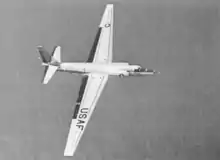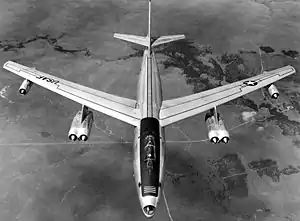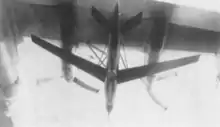United States aerial reconnaissance of the Soviet Union
Between 1946 and 1960, the United States Air Force conducted aerial reconnaissance flights over the Soviet Union in order to determine the size, composition, and disposition of Soviet forces. Aircraft used included the Boeing B-47 Stratojet bomber and—from 1956—the Lockheed U-2 spy plane specifically designed for high-altitude reconnaissance flight. The overflight program was ended following the 1960 U-2 incident.

Background
Reconnaissance flights began in 1946 along the borders of the Soviet Union and other Eastern Bloc states. The necessity of peacetime overflights was reinforced after the escalation of the Cold War in the late 1940s, and in particular after the Korean War began in 1950. U.S. President Harry S. Truman authorized selected overflights of the Soviet Union in order to determine the status of its air forces. It was feared that the Soviets might launch a surprise aerial attack on the United States with long-range bombers.[1]:91–92

Cross-border droppings
On several occasions in 1951-1952, CIA planes flew over the Soviet territory, penetrating the airspace near the borders of its westernmost republics (Moldovan SSR, Ukrainian SSR, and Belarussian SSR,) dropping parachutist agents recruited in the West from the Soviet defectors (the AEDEPOT project.) Most of the landed agents were captured by the Soviet troops and government agencies. The agents were disguised as ordinary Soviet citizens, and equipped with fake Soviet passports, guns, grenades, explosives, disguised firing devices, and other spy equipment. They were detailed to contact local anti-Soviet rebels, and engage in a guerrilla warfare against the local Soviet authorities.[2]
First deep-penetration flights
In 1952 a modified B-47B bomber made the first deep-penetration United States overflight of Soviet territory to photograph Siberian air bases. Limited periphery flights had already been conducted by American aircraft, including the signals intelligence RB-29, RB-50, and RB-47.
Overflights of the Soviet Union with the newly designated RB-47Es started in 1954, often at great risk as they were routinely intercepted by Soviet MiGs. It became apparent that a new aircraft was needed which could operate at altitudes well above any Soviet air defenses.[1]
U-2 missions
In November 1954, President Dwight D. Eisenhower approved a secret program under the direction of the Central Intelligence Agency to build and fly a special-purpose high-altitude reconnaissance aircraft with the code name AQUATONE. Lockheed was chosen to build the reconnaissance plane and in August 1955 the first Lockheed U-2 was test-flown.
Other strategic reconnaissance missions continued as the U-2 tests were ongoing. In early 1956 Project Genetrix involved hundreds of high-altitude photographic reconnaissance balloons that were intended to collect intelligence as they drifted across the Soviet Union; only 51 balloons were recovered, however and just 31 of those provided any usable photos.
During Project HOMERUN (between March and May 1956) RB-47E reconnaissance aircraft flew almost daily flights over the North Pole to photograph and gather electronic intelligence over the entire northern section of the Soviet Union.
On 6 May 1956 six reconnaissance bombers, flying abreast, crossed the North Pole and penetrated Soviet airspace in broad daylight as if on a nuclear bombing run. Any Soviet radar operator seeing the bombers would have no way of knowing that the mission was an act of espionage and not of war.[3]
On 4 July 1956 the first U-2 flight over the Soviet Union took place. Soviet leader Nikita Khrushchev angrily protested this overflight and feared that "when they understand that we are defenseless against an aerial attack, it will push the Americans to begin the war earlier."[4] This prompted the Soviet Union to develop new air defense systems.
Strategic overflight reconnaissance in peacetime became routine U.S. policy. The CIA's Project OXCART, an aircraft which flew even higher and four times faster than the U-2, advanced aerial overflight reconnaissance capabilities with eventual development of the Lockheed SR-71 Blackbird.
Discontinuance
Following the 1960 U-2 incident, Eisenhower ordered an end to American reconnaissance flights into the Soviet Union. This policy was upheld by President Kennedy. On 25 January 1961 he told a press conference, "I have ordered that the flights not be resumed, which is a continuation of the order given by President Eisenhower in May of last year."[5]

Kennedy's successor, Lyndon B. Johnson, elected to continue the policy of no overflights. Improvements in technology during the 1960s allowed satellite reconnaissance which was immune to intercept and provided much of the same information that could be obtained by reconnaissance aircraft, thus rendering aerial overflights unnecessary. In 1964 CIA director John A. McCone emphasized to the Johnson administration the orders were not a pledge barring further flights, but simply a directive that the flights not be resumed, one which can be countermanded.[5]
In spite of the formal end to reconnaissance aircraft overflights, the U.S. remained involved in overflight attempts of its Cold War adversaries. Project Dark Gene, a CIA–Iranian program of intrusions into Soviet airspace to explore Soviet air defense systems, continued operations up to 1979. Aerial reconnaissance of mainland China continued with the Ryan Model 147 "Lightning Bug" RPVs (Remotely Piloted Vehicles); several of these drones were shot down or recovered by the Chinese during the Vietnam War era. China overflight efforts prevailed into the 1970s with proxy U-2 missions flown by Taiwanese pilots.
Legacy
More than 40 U.S. aircraft were downed by Soviet forces and 200 Americans were killed during these operations. Their families were given false information by the army on the circumstances of their deaths.[6]
See also
References
- Notes
- Citations
- Mark Natola, ed. (2002). Boeing B-47 Stratojet. Schiffer Publishing Ltd. pp. 85–97. ISBN 0764316702.
- Dozornye zapadnyh rubezhey: dokumental'nye ocherki po istorii voysk Krasnoznamyonnogo Zapadnogo pogranichnogo okruga (in Russian). By I. A. Kurolenko, V. A. Kozlov, Zh. D. Bragin, N. D. Borovkov. 2nd edition. Kiev, 1984. pp. 232-233.
- https://web.archive.org/web/20120101112547/http://www.allbusiness.com/buying_exiting_businesses/3580596-1.html
- Burrows, William E. (1999). This new ocean : a history of the first space age (1st paperback ed.). New York: Random House. ISBN 0-375-75485-7.
- Pedlow, Gregory W. and Welzenbach, Donald E., 'The Central Intelligence Agency and Overhead Reconnaissance; The U-2 And Oxcart Programs, 1954-1974', Central Intelligence Agency History Staff, 1992. SECRET, declassified 25 June 2013. Retrieved: 2 February 2014.
- James Bamford (1 January 2002). "Clandestine air war: The truth. Cold War US surveillance flights". allbusiness.com. Archived from the original on 1 December 2011. Retrieved 13 October 2010..
- Bibliography
- Boyne, Walter J. "Airpower Classics: B-47 Stratojet." Air Force Magazine, August 2007, Air Force Association. Retrieved: 4 June 2009.
- Boyne, Walter J. "The Long Reach Of The Stratojet." Air Force Magazine Vol. 66, issue 71, December 1997.
- Bowers, Peter M. "The Boeing B-47" Aircraft in Profile, Volume 4. Windsor, Berkshire, UK: Profile Publications Ltd., 2nd revised and enlarged edition, 1970. ISBN 0-85383-013-4.
- Goebel, Greg. "RB-47S in the Cold War." vectorsite.net.
- Guerriero, Major Robert A. "Space-Based Reconnaissance." armyspace.army.mil.
- Pocock, Chris. 50 Years of the U-2: The Complete Illustrated History of Lockheed's Legendary Dragon Lady. Atglen, PA: Schiffer Pub. Ltd., 2005. ISBN 0-7643-2346-6.
- The World's Great Stealth and Reconnaissance Aircraft. New York: Smithmark, 1991. ISBN 0-8317-9558-1.
External links
- B-47
- "A Tale of Two Airplanes" by Kingdon R. "King" Hawes, Lt Col, USAF (Ret.)
- U.S. Defectors Aid Soviet ‘Spy’ Charges Aviation Week & Space Technology, September 12, 1960
- Defectors Termed No Threat to U.S. Codes Aviation Week & Space Technology, September 26, 1960
- Cargill Hall on: U.S. Need for Soviet Information
- Cargill Hall on: British Pilots Flying Over the Soviet Union
- Cargill Hall on: SAC Intelligence Gathering
- Cargill Hall on: U.S. and Soviet Fears of a Surprise Attack